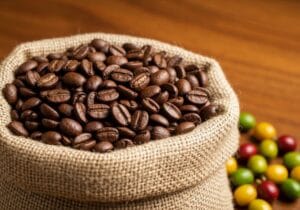Coffee cycle roasting is like a wild journey for green beans! Initially, they dry out, shedding moisture and turning yellow—who knew beans could get a tan? Then, they enter the browning stage, where sugars caramelize, creating those bakery-like aromas that make you go, “Mmm!” Ultimately, the magic of caramelization adds sweet notes and deep complexity. Each step matters in crafting that perfect cup! Stick around to find out even more about why this process is a game changer!
Key Takeaways
- The coffee roasting cycle consists of multiple phases: drying, browning, caramelization, and more, each contributing to the flavor profile.
- The drying phase removes moisture, preventing microbial contamination and influencing roast quality.
- During the browning stage, sugars caramelize, enhancing aroma and flavor development essential for a rich coffee experience.
- The caramelization phase adds complexity and sweetness to the coffee’s flavor, building on insights from previous stages.
- Consistency in roasting ensures a balanced flavor, as uneven roasts can lead to undesirable flavor outcomes.
Stages of Coffee Cycle Roasting
In the context of the stages of coffee cycle roasting, it’s like orchestrating a symphony, but instead of instruments, you’ve got green coffee beans going from raw and shriveled to a glorious roasted masterpiece!
Initially, there’s the drying phase, where those beans drop about 10-12% of their moisture. Picture them at a sauna, slowly shifting to yellowish hues—no flavor fireworks yet, but boy, does it set the stage! This stage helps to prevent microbial contamination, ensuring the beans are safe for consumption. The moisture content at this phase is crucial as it dictates the drying duration and influences potential roasting issues.
Then comes the browning stage, where the real magic happens—sugars start caramelizing around 200°C (392°F). Suddenly, beans go from blah to wow, bringing out sweet, toasted notes, like a bakery in your kitchen. This transformation is crucial because it significantly impacts the aroma and flavor profile of the final coffee brew.
It’s a wild ride, from moisture to mouthwatering!
Importance of Each Phase
Roasting coffee isn’t just a science; it’s an art form that turns those little green nuggets into the heavenly brew many can’t start their day without! Each phase of roasting, from the drying phase to the development phase, plays a vital role in developing that perfect cup.
| Phase | Importance |
|---|---|
| Drying Phase | Removes moisture, kick-starting flavor development. |
| Browning Phase | Creates rich aromas via the Maillard reaction. |
| Caramelization Phase | Adds sweet notes, enhancing flavor complexity. |
During the drying phase, moisture evaporates like a dramatic exit at a party, setting the stage. The browning phase is like a flavor party where things really heat up! This phase is also where the foundation for the coffee’s rich aromas is established. After that, caramelization kicks in, bringing sweetness! Then, the development phase fine-tunes everything, making it just right. It’s a wild ride in a coffee bean’s life! Ultimately, each phase is crucial for achieving high-quality beans that satisfy coffee enthusiasts and reflect the unique characteristics of the beans’ origin.
Final Considerations on Roast Quality

Steering the winding path of roast quality can feel like trying to solve a Rubik’s Cube blindfolded—complex and a little frustrating! To nail that perfect brew, roast consistency is your trusty sidekick. It’s like your GPS for flavor preservation!
Uneven roasts can lead to that terrible moment—taking a sip, only to cringe at burnt notes fighting with sour surprises. Nobody wants a rollercoaster in their cup! Achieving a smooth surface post-first crack? That’s a victory dance folks!
Frequently Asked Questions
What Types of Coffee Beans Are Best for Roasting?
Arabica beans are ideal for light to medium roasting, highlighting complex flavors. Robusta beans suit dark roasts for boldness. Single origin beans excel in clarity, while blend varieties balance flavor profiles effectively across different roast levels.
How Does Roasting Time Affect Coffee Flavor?
Roasting time considerably influences coffee flavor profiles, with shorter durations preserving acidity and brightness at lower roasting temperatures, while longer durations deepen bitterness and smokiness, creating complex flavors through caramelization and chemical reactions during the roasting process.
Can Homemade Roasting Replicate Professional Results?
Homemade roasting techniques can approach professional results but often fall short in achieving complex flavor profiles. Inconsistencies in control and cooling impede reproducibility, though dedicated practice may improve outcomes in personal roasting endeavors.
What Equipment Is Needed for Coffee Roasting at Home?
For home roasting, essential tools include a roasting machine (either a drum or hot air type), cooling trays, temperature sensors, scales for measurements, proper storage bags, and optional grinders to improve the coffee experience.
Is It Possible to Over-Roast Coffee Beans?
Yes, it is possible to over-roast coffee beans. This results in a burnt flavor profile, compromising the original roast level and diminishing the desirable complex flavors, ultimately leading to a bitter, unbalanced cup of coffee.
References
- https://en.wikipedia.org/wiki/Coffee_roasting
- https://tincup.coffee/2019/01/25/the-basics-of-coffee-roasting/
- https://cafealtura.com/coffee-roasting-phases/
- https://loring.com/how-to-influence-flavor-profile-of-coffee/
- https://rareearthcoffee.com/blogs/air-roasted-whats-the-difference/the-different-factors-of-roast-levels-and-coffee-roasting-a-comprehensive-guide





